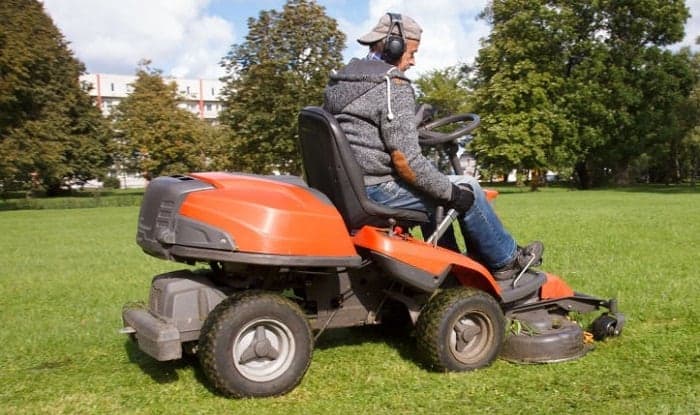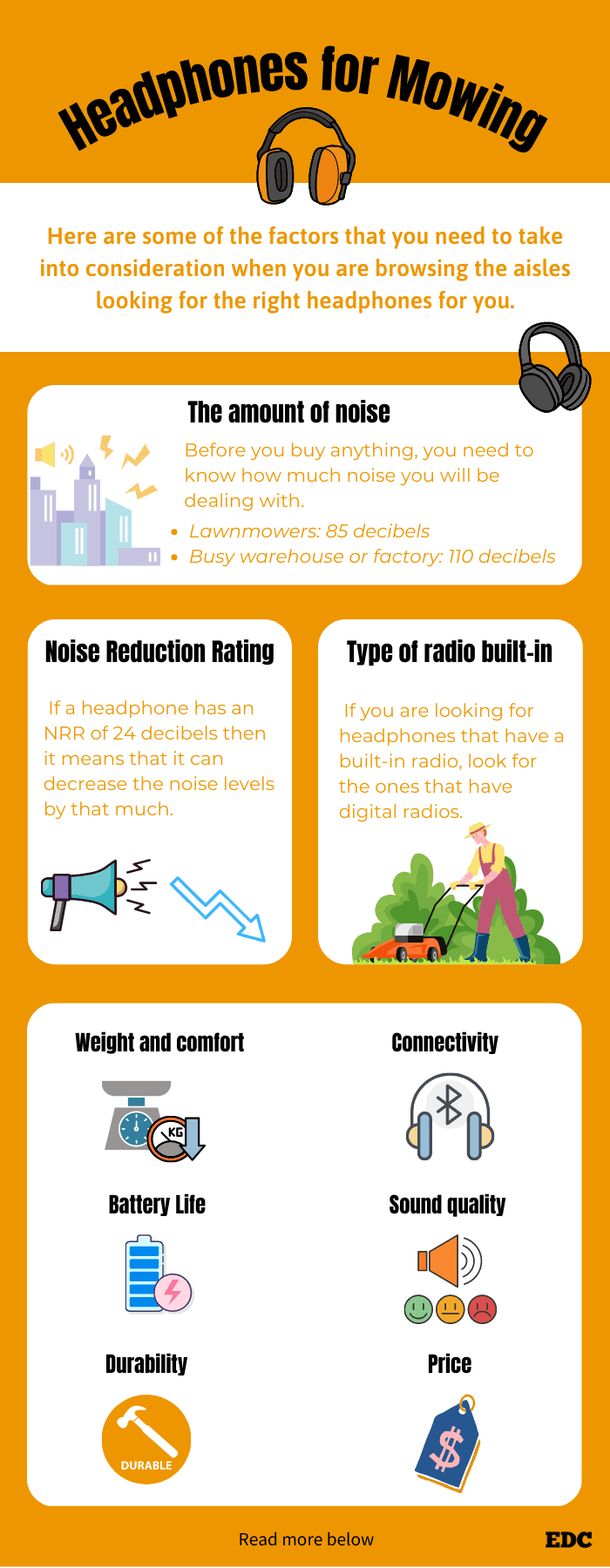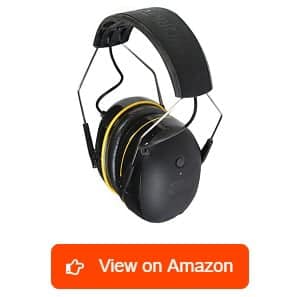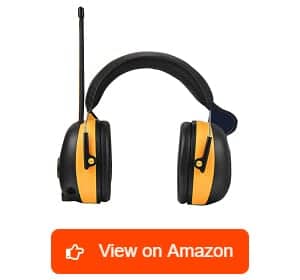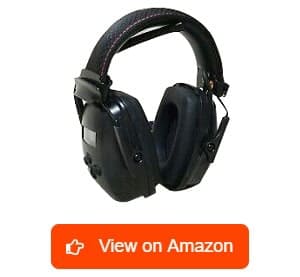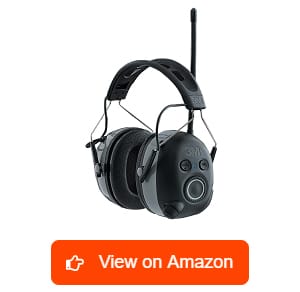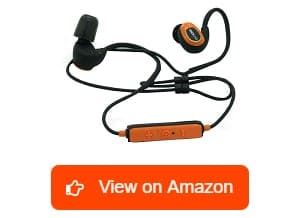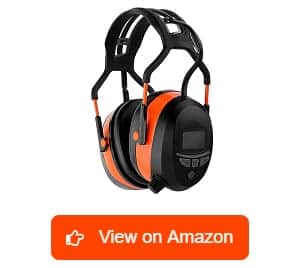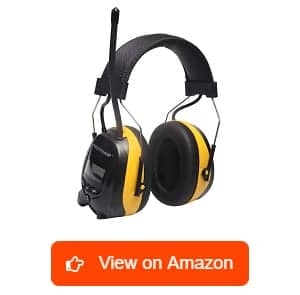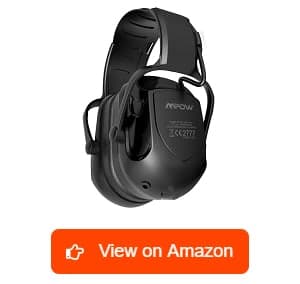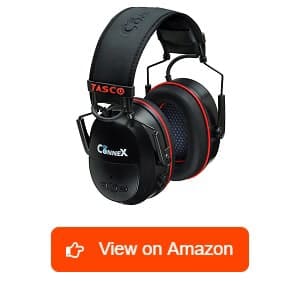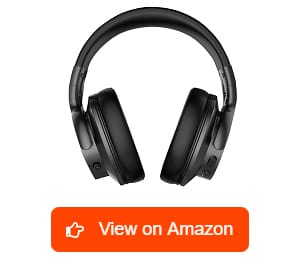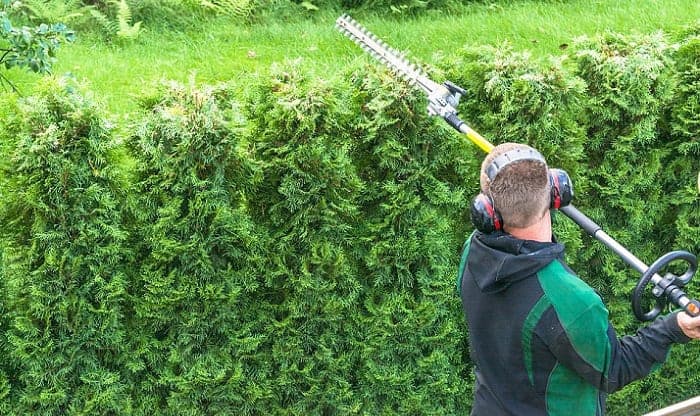You might be thinking why you would need the best headphones for mowing but the question should be “why not?” Why would something as relaxing as mowing your lawn during the weekends need protective gear?
It is mainly because you are doing irreparable damage to your hearing, though you haven’t noticed how much harm you have done so far. Recount how many hours of work you have already logged while mowing your lawn throughout the years and you will realize that you have made a considerable dent in the health of your ears.
According to the Occupational Safety and Health Agency (OSHA), being exposed to noises that reach 85 decibels for 8 hours is enough to cause permanent damage to the nerve ending in the inner ear. Here is the worst part, every 3 decibels beyond 85 decibels will halve the amount of time needed to cause damage.
This means you only need 4 hours of exposure to 88 decibels of noise to cause hearing damage. The bad news is that your lawnmower can easily generate 85 decibels of noise, especially if it is already a couple of years old. So yes, you have been causing considerable harm to your hearing for a while now.
However, that does not need to be the case anymore. Now that you know about the harm that you have been inflicting on yourself, it is time to start protecting yourself by wearing top-quality headphones for lawn mowing.
Table of Contents
- List of Top-Tier Headphone for Mowing Reviews of 2023
- 1. 3M WorkTunes Connect Hearing Protector
- 2. ZOHAN EM042 AM/FM Digital Hearing Protector
- 3. Honeywell Howard Leight Sync AM/FM Radio Earmuff
- 4. 3M WorkTunes Connect + AM/FM Hearing Protector
- 5. ISOtunes PRO Bluetooth Earplug Headphones
- 6. WULFPOWERPRO FM MP3 Bluetooth Radio Headphones
- 7. PROTEAR AM/FM Radio Headphones
- 8. Mpow HP102A Noise Reduction Bluetooth Safety Earmuff
- 9. CONNEX Bluetooth Hearing Protector Over-the-head Earmuffs
- 10. Avantree ANC031 Hi-Fi Sound Noise-canceling Bluetooth Headphones
- What is a Headphone for Mowing
- How Do Headphones for Mowing Work
- Types of Headphones for Mowing
- Why Do You Need Headphones for Cutting Grass
- Buying Guide
- Care and Maintenance
- Frequently Asked Questions
- Conclusion
List of Top-Tier Headphone for Mowing Reviews of 2023
1. 3M WorkTunes Connect Hearing Protector
What immediately impressed me about the 3M WorkTunes is its high-quality speaker. This choice of ear protection for lawn mowing comes with 40mm drivers that are comparable to many premium headphones out in the market today. For me, these do not just serve as work headphones because they have superb functionality.
I also use them sometimes when I just want to listen to my favorite tunes. I am also glad that I can enjoy my music and protect my hearing at the same time because these headphones have an NRR of 24 decibels. This is perfect when I am driving my ride-on lawnmower.
It is because they decrease the noise from around 85 decibels to a very comfortable level of 61 decibels. This means you can do your job longer without worrying about causing damage to your hearing anymore. It is also nice that these headphones are completely wireless.
These come with Bluetooth connectivity so you can connect them to your smartphone. With that, you can play your favorite music without having to deal with pesky wires. It gets better. You can easily pair the headphones using just one button. You just need to follow the voice assist instructions.
Another thing I like about the 3M WorkTunes Bluetooth headphones for mowing is that it has a high-quality microphone built-in. What this means is that when it is connected to a smartphone, the WorkTunes can be used as a hands-free headset. You can answer phone calls without having to pull out your phone or even remove the headset.
- High-fidelity sounds, thanks to the 40-mm speakers
- Has Bluetooth connectivity, which ensures that there will be no need for wires
- Can block 24 decibels of noise
- Useful as a wireless phone headset
- Has an excellent battery life
- Can get a bit warm
2. ZOHAN EM042 AM/FM Digital Hearing Protector
It is quite impressive to find out that protective headphones like the Zohan EM042 can produce great sounds. The speakers are a decent size and they can somehow accurately reproduce high and mid-tones. These headphones also have decent bass production, not quite mind-blowing but very passable in my opinion.
It is also a good thing that these Zohan headphones have excellent sound quality due to the built-in digital radio. The neat thing about digital radio is that it has much clearer broadcast signals. Whenever I am listening to music on the FM band, it sounds like I am listening to an audio CD.
These headphones also come with an auxiliary input jack so that I can plug them into my smartphone whenever I want to listen to my playlists and there truly is nothing worth listening to on the radio.
These headphones for cutting grass are also comfortably padded. There is enough foam padding on the ear pads and the headband, making the process of wearing them for hours comfortable. The foam padding is also soft enough that it completely conforms to the shape of my ears. This creates a nice barrier to protect against loud noises.
- Has an excellent sound quality
- Boasts of nice bass production
- Comes with an aux input jack and aux cord
- Boasts of excellent battery life
- Features digital radio built-in
- The radio has a very limited range.
3. Honeywell Howard Leight Sync AM/FM Radio Earmuff
These headphones have decent sound quality. Although these will not impress audiophiles, this will be more than enough to keep you entertained if you just want above-average sound quality when you are working.
These lawn mowing headphones with radio use a patented airflow system to increase their noise-blocking capabilities. This means the ear cups are thinner and lighter compared to the other brands, making them quite comfortable to wear.
There is also a built-in digital radio receiver in these headphones. Combined with the nice-sounding speakers, the digital radio provides a nice listening experience. Not only is the sound quality of digital radio vastly superior to analog but I am also pleased that I do not have to deal with static.
Also, the reception of these headphones is quite excellent. I have to give Honeywell credit for providing the 2AA batteries required to operate these headphones. I was able to use them immediately after opening the package, thanks to this. The batteries also lasted a surprisingly long time, almost 25 hours by my count, which is quite impressive.
- Has an above-average sound quality
- Comes with a digital radio
- Boasts of excellent radio reception
- Already comes packaged with two AA batteries
- Superior battery efficiency guaranteed
- The radio resets to default when changing batteries.
4. 3M WorkTunes Connect + AM/FM Hearing Protector
This hearing protector is quite the same as the WorkTunes Connect but this model has a built-in digital radio. You will have even more listening options while you are working. The good news about having this item is that you do not have to deal with pesky wires.
Speaking of the digital radio, the built-in antenna on these headphones provides excellent range. I have yet to find a spot in my yard where there is a dead spot or a place where the radio could not get a strong enough signal to keep playing.
I am also impressed with this WorkTunes Connect+ headphone’s large and beefy controls. The knobs and buttons are large enough that you can easily manipulate them even when I am wearing thick work gloves.
These safety headphones can also be used as hands-free phone headsets for your smartphones. These headphones have an integrated microphone that can block excessive background noise so every call that you make is always crystal clear. Do take note that this feature is only available when the headphone is connected via Bluetooth.
- Comes with a digital radio tuner
- Features a Bluetooth and auxiliary input jack for more listening options
- Can be used as a hands-free set for smartphones
- Has excellent radio reception
- Has thick ear cup padding that is both comfortable and blocks sound
- Can get uncomfortably hot after a while
5. ISOtunes PRO Bluetooth Earplug Headphones
Even though these earbuds are tiny, the ISOTunes Pro can truly and effectively block a lot of noise. The ISOTunes have memory foam tips that expand when exposed to a bit of heat, thereby creating a good seal inside your ear. These are OSHA-compliant and have an NRR of 27 decibels, higher than most of the other protective headphones on this list.
These headphones for chainsaw are also equipped with the latest Bluetooth connection technology. I love that this earplug headphone can remain connected to my smartphone even when I am more than 30 feet away from it. This is very convenient because I do not need to carry my phone while I am at work.
These tiny speakers also have exceptional battery life. I discovered these have a battery that can last an entire workday’s worth of use. Also, according to the packaging, they can last for 10 days on standby mode. The top-tier part is that they only take less than 4 hours to fully charge.
The top-tier thing about this earbud is that it is built tough. These are waterproof as these are rated at IP55. This means that they can last more than an hour even when submerged under a meter of water. This also makes the earplugs improve their ability to handle sweat and even a bit of rain.
- Compact and lightweight design
- Excellent Bluetooth range
- Boasts of impressive battery life and short charging time
- Has an excellent NRR of 27 decibels
- Waterproof and sweat-proof
- The microphone is less than desirable.
6. WULFPOWERPRO FM MP3 Bluetooth Radio Headphones
The Wulfpowerpro protective headphones have the highest NRR of all those I have tried so far with its impressive 29 decibels. This rating is more than enough for tasks such as mowing the lawn. You can use it in environments that push around 100 decibels of noise, like a busy factory floor.
I also love that I have the option to use Bluetooth connectivity and the aux input jack. I would rather use the Bluetooth connection when I am working because this allows me to move around more freely. It is because I do not have to deal with cables.
However, when I just want to sit back and listen, I would rather use the aux cord as it does not use up too much battery. Aside from playing audio from external devices, these headphones also come with a built-in digital FM radio. I also like that I just need to push one button to scan the airwaves for any available signals then save them into presets for quicker access later.
Even though there is no external antenna, the reception that the radio gets is great. The rechargeable battery has a capacity of 800mAh, which I discovered could last between 10 to 11 hours of continuous playback. However, if you will be using it for several hours at a time, the battery can last for around 15 hours.
- Has an impressive NRR of 29 decibels
- Quick and easy to pair using Bluetooth
- Boasts of a good battery life
- Quick to charge; the rechargeable battery needs no more than four hours of charging.
- Has a built-in digital radio tuner
- These are passive noise-reducing headphones despite what the packaging states.
7. PROTEAR AM/FM Radio Headphones
The Protear headphones have an NRR of 25 decibels, which is more than enough for a lot of noisy workplaces. These items have thick foam padding in the ear cups that can block a huge chunk of environmental noise.
I like the digital radio that came built into the headphones. One of the ear cups has a clear LCD screen that displays the station frequency and the preset number. This makes it easy to browse the airwaves for my favorite AM and FM stations and save them into the presets for easier access later.
Even though these headphones are large and look heavy, they are pretty comfortable to wear and lightweight to boot. The ear cups have a thick foam padding wrapped in thin and breathable PU skin. This is what makes the product able to block most of the noises from outside.
This headphone’s high NRR means that you can use it for a variety of applications. These muffs can decrease the noise enough that you can use them for hunting, mowing the lawn, watching motorsports, and in construction sites to say the least.
- Has an impressive NRR of 25 decibels
- Very lightweight and has enough padding for exceptional comfort
- Comes with an LCD screen for easy navigation
- Can be used in several different applications
- Has an auxiliary input jack for external audio sources
- Not so good radio reception
8. Mpow HP102A Noise Reduction Bluetooth Safety Earmuff
The most impressive feature of the Mpow HP102A is its NRR (Noise Reduction Rating) of 29 Decibels. This is the highest NRR that I have seen in protective headphones that are not technically noise-canceling. This makes these headphones ideal even for extremely noisy environments.
The reason why these noise-canceling headphones for mowing lawn have such a high NRR is that there is a thick foam padding in the ear cups. The foam is quite dense but still soft enough to follow the shape of the ears to make a good seal. The foam is then covered by a thin layer of PU leather. This material is quite strong and breathable.
All these qualities combined mean that these headphones are extremely comfortable and suitable for hours of use. I also like that you can choose between Bluetooth and aux cord if you want to connect the Bluetooth headphones for outdoor work to a smartphone or an MP3 player.
If I am at work, I would prefer the Bluetooth connection as it frees me from the hassles of having to deal with the aux cord. I have more freedom of movement so to speak. The battery life of this headphone is also very impressive. I can get up to 30 hours of use from one full charge.
This becomes a bit more serious for me because I also need to wear glasses and these headphones have slightly bent the temples.
- High NRR at 29 decibels
- Has nice and thick padding on the ear cups and headband
- Nice sound quality, thanks to the large speakers
- Comes with both Bluetooth and aux input jack
- Has a long battery life
- The headband is a bit too tight for people with glasses.
9. CONNEX Bluetooth Hearing Protector Over-the-head Earmuffs
These are genuine ear protection headphones and as such, they are certified to have an NRR of 25 decibels. Although these earmuffs do not have active noise-canceling functions, it does have excellent passive noise-isolation capabilities.
I also like that I can still use the auxiliary port to plug in my smartphone or MP3 player when I do not feel like listening to the built-in digital radio. I just need to plug in the aux cord into the 3.5mm jack and plug the other into the input jack.
However, I also like the Bluetooth connectivity of these headphones. They have a great range (a maximum of 30 feet) before the Bluetooth connection breaks and this is more than long enough. It is also easy to pair these headphones to any smart device. You just need to press one button.
The most impressive feat that these headphones can do is up to 60 hours of continuous use and five days on standby. These headphones are powered by three AAA batteries that are also included in the package.
- Incredible battery power efficiency
- Already comes with three AAA batteries
- Awesome battery efficiency
- Bluetooth connection is very stable
- Still retains the aux input jack
- The digital radio can only receive FM signals.
10. Avantree ANC031 Hi-Fi Sound Noise-canceling Bluetooth Headphones
Unlike the other Bluetooth headphones on this list, the Avantree ANC031 has active noise-canceling capabilities. With just a flip of a switch, the ANC will produce a canceling sound wave to counteract the distracting low-frequency noises in the background.
On the other hand, the thick foam padding on the ear cups handles the high-frequency sounds. This will place you in an almost completely silent world. Aside from the effective ANC, the Avantree ANC031 has precision-engineered, high-quality 40mm drivers that pump out high-quality sounds.
Combined with the advanced Bluetooth CSR technology, these drivers can produce sound quality that is comparable to a wired connection. These are more than just the best headphones for mowing. There are controls on the ear cups that allow you to answer phone calls if the headset is paired to your smartphone.
You can also use certain controls for muting the microphone while in the middle of a call, volume controls, and music playback. The battery life of these headphones is amazing, too. With a full charge, I was able to play music for a total of 28 hours (maybe a bit more) before I needed to recharge the headphones again.
Of course, these might have better noise reduction capabilities compared to the others in this list but without an NRR, no professional company will allow their workers to use them in the workplace.
- Superb sound quality
- The Bluetooth connection does not lag and has almost the same quality as corded ones.
- Very long battery life
- Can control everything (phones and media) from the headphones
- Has true active noise-cancelation
- Cannot be used in professional worksites due to lack of NRR certification
What is a Headphone for Mowing
For a protective headphone to become suitable for mowing the lawn, it has to have at least an NRR that can lower the amount of noise that reaches your ears. In this instance, since lawn mowers can produce up to 85 decibels of noise, the baseline for hearing damage, anything that has a rating of at least 20 decibels will do.
Fortunately, almost all headphones for hearing protection have an average NRR of 25 decibels. Now that hearing protection is already covered, the other factors will fall into place. These factors include the fit and comfort of the headphones.
They need to be quite comfortable so that you can easily convince yourself to wear them every time you start up your lawnmower. Another factor is entertainment. The headphones should not just be able to block noises.
They should also be able to play music to give you a fun experience while at work. This will prevent you from getting bored when working.
How Do Headphones for Mowing Work
Headphones for mowing are used to significantly decrease the amount of noise that reaches the ears down to a healthy level. According to the OSHA, an 8-hour exposure to noises that is just 85 decibels loud is enough to cause permanent damage to a person’s hearing. This so happens to be the amount of noise that most ride-on mowers produce.
The way that most of these headphones work is through the use of passive noise isolation. This means that there are no active noise-canceling devices in the headphones. The way that the ears are isolated from the noise coming from the environment is through passive means.
These include using thick foam padding to create a seal around the ears and a tight-fitting but still comfortable headband to hold the earphones firmly in place.
Types of Headphones for Mowing
If you will be categorizing headphones in terms of their shape then you will most likely come across two. These include:
Earbuds – These are small earphones that have silicone and memory foam inserts that go straight inside your ears. These work just like earplugs. They create a seal just inside your ears to prevent excessive noise from getting in.
Most of the time, these are more effective in blocking noises but they come at the expense of durability as the earbuds will usually deteriorate after a month or so of regular use.
Over-the-ear Headphones – Unlike earbuds, these ear headphones are large and cover the ears instead of plugging them up. Headphones have thick foam padding that conforms to the shape of the ears, creating a seal that minimizes the amount of noise that reaches them.
This option for hearing protectors is quite popular in countries where the weather is usually cold as they can also double as earmuffs. However, when used in warmer climates, these can get unbearably hot.
Now if you will be grouping headphones in terms of how they minimize sounds, your options include:
Passive Noise Reduction – These are protective headphones that rely only on passive forms of noise reduction. This is the thick foam and the headband, providing just enough pressure on the ear cups to keep them in place on your head.
Active Noise Reduction – These headphones also use passive noise reduction but in addition to it, they can also use active noise-cancellation technology to further lower the amount of noise that your ears hear.
In a nutshell, active noise-cancellation technology involves the use of a small microphone outside the earphones that scan for low-frequency noises (these are the ones that cannot be blocked using passive means).
It then passes on the data to a tiny processor inside the earphones that will create a sound that is the inverse of the one coming from outside. This will cause them to cancel each other out.
Why Do You Need Headphones for Cutting Grass
One of the most important reasons why you need headphones when you are just cutting grass is because it will protect you from massive hearing loss later. You might think that you are tough for enduring all lawnmower noise coming from your years’ old machine but the truth is, you are gradually destroying your ears.
Just 85 decibels over 8 hours is enough to cause irreparable hearing damage and the amount of time gets cut in half with every three-decibel increase. This means that if your old lawnmower is generating 88 decibels of noise, it just needs 4 hours to cause permanent hearing loss.
Here’s the even worse news, hearing loss can never be healed. Once you have done considerable damage to the nerve endings that are found inside your ears, they can no longer regenerate or heal themselves. Yes, you can use hearing aids but these will never be the same as when you have a healthy hearing.
So, the next weekend, before you get on your ride-on mower, seriously consider wearing hearing protection so that you can still hear properly in ten or so years.
Buying Guide
If this is the first time you will be buying noise-reducing headphones, chances are that you don’t know what to look for. Also, because there are so many brands and models of headphones to choose from, it gets even harder to decide on just one.
To help you out, here are some of the factors that you need to take into consideration when you are browsing the aisles looking for the right headphones for you.
The amount of noise in your workplace – Before you buy anything, you need to know how much noise you will be dealing with. If you will only be using the headphones while you are mowing your expansive lawn area, know that most ride-on lawnmowers can get as loud as 85 decibels, which is the starting point of hearing damage.
If you will also be using it for work, like let’s say you work in a busy warehouse or factory, the noise levels can get as high as 110 decibels, depending on the place. Once you know how much noise you will be dealing with, you can proceed to the next step, which is narrowing down your choices according to their NRR.
Noise Reduction Rating – Also known as NRR, Noise Reduction Rating is given by laboratory testing bodies credited by the government. For example, if a headphone has an NRR of 24 decibels then it means that it can decrease the noise levels by that much.
If you will be using the headphones in an environment where the surrounding noise gets up to 100 decibels, you can lower it to just around 76 decibels, which is already considered as safe. You have to consider the NRR because you do not want to get headphones that could not lower the background noises enough.
Also, you do not want to overcompensate as the higher the NRR becomes, the more expensive the headphones usually are. It is best to get headphones that provide a bit more hearing protection than what you need but make sure this is not too much.
Weight and comfort – It seems counterproductive to buy headphones that you do not feel comfortable wearing. It just gives you a reason not to wear hearing protection, which is never good. When it comes to hearing protection, it does not have to be black and white.
If it protects your ears then it could not be comfortable or if it is comfortable then it does not protect your hearing. You can find headphones that are comfy and effective at protecting your hearing. First of all, check out the padding on the ear cups and the headband.
The padding on the ear cups serves two purposes. The first purpose is to create a seal that prevents excess noise from getting inside the headphones while the second is to provide a cushion to make wearing them comfortable. Make sure that the padding is thick enough to be comfortable while providing enough material to block sounds.
The headphones should also not be so heavy that they tend to slide off your head all the time and/or make the headband press uncomfortably against your head. Ideally, the headphones should be light enough that you do not even notice you are wearing them after a while.
Lastly, the ear cups need to be breathable. Many headphones out there can get unbearably warm after an hour or so of wearing and no one likes the feeling of having sweaty ears. Look for headphones that allow your ears to breathe a bit without compromising hearing protection too much.
Type of radio built-in – If you are looking for headphones that have a built-in radio, look for the ones that have digital radios. This type of radio is exponentially better than analog AM/FM radios. First of all, the sound quality is so much better in digital radios.
When listening to music in FM, it is comparable to the sound quality that you get from an audio CD. Be mindful when you are out shopping for headphones as not all of them have built-in radios. Some are just regular models that can connect to other devices like your mobile phone and mp3 player.
Connectivity – Speaking of connections, you can also connect the headphones to an external device for audio playback, aside from the radio. You can either choose from headphones that have an auxiliary input jack, one with Bluetooth connectivity, or both.
The great thing about using the aux input jack (via an aux cord) is that it saves on battery. When plugged into a smartphone or an MP3 player, the headphones will draw power from the external device instead of using their battery. However, you have to deal with a cable dangling by your side at all times.
Bluetooth connectivity allows for more freedom of movement as there are no cables to contend with. However, it does drain the battery faster – both in the headphones and the device that it is connected to.
Battery Life – The average battery life that you can get from protective headphones is around 24 to 30 hours. This is continuous use with the built-in radio or connected via Bluetooth to an external device. This is the benchmark for headphones powered by two AA batteries or 700 mAh rechargeable batteries.
However, some headphones use three AAA batteries and these have even longer battery lives, up to 40 hours of continuous use. You should choose the ones that have the longest battery life so that you can enjoy using them longer.
Sound quality – If you are a music lover then you need to get protective headphones that do not only provide excellent hearing protection but also produce high-quality sounds. Two vital components contribute to the sound quality of the headphones – the audio drivers and the speakers.
The sound drivers are the components that produce the sounds and the speakers amplify them. The larger the drivers and speakers are, the clearer and more robust the sounds. However, this also means that the headphones will get bigger and heavier.
Try to find a balance between size and sound quality but get headphones that have speakers and drivers that are 30mm or bigger. These will be enough to give you great sound quality without contributing too much weight.
Durability – Since you will be using the headphones in a worksite and you will be moving quite a bit as well, it is almost certain that you will accidentally drop them at least once. You need to get headphones that are built tough – the ones that are made mostly of metal and tough plastic.
These items can survive falls from heights of at least three feet onto hard concrete and come out fairly unscathed. This is the reason why you should not use those expensive noise-canceling headphones that are meant solely for listening to music. They have very delicate internal parts that could get damaged from just a slight fall.
Price – To come up with a justifiable price, you need to consider how many times you will be using the headphones. If you will be using the headphones for other tasks other than lawn mowing (if you have a woodturning hobby, for instance) then you should invest in a good quality pair of very durable headphones.
However, if you will only be using the headphones during the weekends or every other Saturday, then you can just get on the more affordable ones. Just take good care of them to make them last longer.
Care and Maintenance
The nice thing about protective headphones is that they do not require too much maintenance. You just need to clean them after every use and prevent them from getting wet.
Cleaning just involves using a damp, clean cloth to wipe the entire surface of the headphones and maybe spraying a bit of disinfectant to kill the bacteria that came from your sweat. This will also keep the foam padding from stinking up.
Frequently Asked Questions
Are lawnmowers loud enough to damage your hearing?
In short, yes. The noise that lawnmowers can range between 80dB to 100dB. Meanwhile, the NIOSH recommends against continuous exposure to noise at 85dBA or above for more than 8 hours. In fact, it has been proven that 2 hours of hearing lawnmowers is enough to cause damage to your ears already.
In other words, for loud machinery, you must wear hearing protection devices. Whether it’s earplugs, earmuffs, landscape headphones, or earbuds for mowing, any form of protection with over 20dB of noise reduction rating will help.
Are wired or wireless headphones better for mowing?
For tractor operators and gardeners, wireless earbuds, earmuffs, or electronic devices are the way to go. This way, your tools will not get caught in wires as you maneuver equipment.
Another advantage of wearing wireless headphones for grass-cutting is that they are compatible with most music-playing gadgets. You don’t have to buy connectors for the 3.5mm jack adapters for phones without an AUX input.
At any rate, many users from online communities, such as Reddit, agreed that wired headphones for landscapers could offer some benefits. For starters, these devices do not need batteries to operate. Moreover, the sound quality of wireless mowing headphones Bluetooth is usually not on par with many wire headphones.
Well, I can’t argue with these observations. But as a landscaper myself, I need freedom of movement, and the wires can be restrictive, so my go-to choice is always Bluetooth headphones mowing devices.
Noise-canceling headphones and noise-isolating ear protection: What’s the difference?
A noise-canceling headset utilizes microphones to capture low-frequency sounds and produce a phase-inverted sound to cancel and neutralize the unwanted background noise.
Both over-ear and in-ear devices can be designed with this technology. But since noise canceling is an electronic process, headphones or earbuds with this feature will need batteries.
Meanwhile, noise-isolating headphones rely on physical barriers to block out mid- to higher-pitched sounds, although the design can vary. Therefore, the user must choose a device that fits the ears well.
That said, noise-isolating headphones do not need batteries to filter sounds unless they are wireless. Moreover, industrial-grade devices of this kind offer excellent protection against the deafening sounds that machines make, whereas most conventional noise-canceling products can’t.
What are the most popular brands of headphones for mowing grass?
There are so many different brands of headphones that you can use while mowing the grass but not all of them can deliver on their promises. However, I have tested quite a number of them through the years and a couple of brands stood out from the rest.
These include 3M, ZOHAN, Mpow, Honeywell, ISOtunes, PROTEAR, WULFPOWERPRO, CONNEX, and Avantree.
What are the top-rated noise-canceling headphones for mowing?
There are not that many true noise-canceling headphones that are meant for work environments. It is mainly because they would be too expensive and they are not that durable. Most of the products that you will find under this category will be passive noise-canceling only. This means they rely on physical barriers to keep noise out.
To keep things simple, the top-rated protective headphones are the ones that have high NRR (noise reduction rating), are comfortable, and suit the particular tasks that they are bought for.
How to set up and use?
There is not much to set up in hearing protection headphones other than adjusting the headband to make sure that it fits properly on your head. The headband should be tight enough that it holds the headphones in place but not so tight that you get a headache after a while.
To wear, make sure that the ear cups completely cover the ears. There should be no gaps where background noise can get through. Other than the fit, you might also need to set up the built-in radio by saving your favorite stations on the channel presets, the instructions for which will depend on the manufacturer (consult the owner’s manual for details).
What is the warranty?
The usual warranty for products like hearing protection headphones is around 30 days or so and they only cover factory defects, not user error. This is why you need to take your headphones through its paces within the warranty period, so when it does give in, you can have it replaced or you can also ask for a refund.
On the other hand, some of the more reputable brands provide 100% satisfaction guarantees. This means, during the warranty period, if you are not completely happy with the product, you can return it and get a full refund on your purchase.
It does not necessarily mean that the products are broken. You do not have to provide any reason at all.
Where to buy?
You can find a couple of brands of hearing protection headphones in many brick and mortar establishments like Walmart or Home Depot. However, regardless of how big the store is, there are usually no more than a dozen or so different brands of protective headphones and that’s being generous.
However, if you manage to find the appropriate pair of hearing protection in a brick and mortar store, you can test it before you buy it and you can also use it immediately, no more waiting for deliveries.
On the other hand, there are also a lot of benefits from buying your protective headphones online. For starters, you have hundreds of brands and models to choose from.
Also, there are many more online retailers so you can compare their prices and choose the top-tier bargain. Most online stores sell their products at much cheaper prices because they have smaller overheads, so you can get the best deals.
Conclusion
Even if you are just going to mow your lawn because of the amount of noise that your lawnmower produces, you are already causing a lot of damage to your hearing. According to the experts, just 85 decibels over a certain number of hours is already enough to cause permanent hearing loss, and that is exactly how much noise your lawnmower makes.
You have already caused significant damage. Stop making it worse and get the best headphones for mowing and preserve your hearing health starting today. You owe it to yourself to protect your hearing. Start wearing protective headphones now and your future self will thank you for it.

Having worked in the field of personal protective equipment for over two decades, Andrew Carnegie is a specialist in the field.
At EDC, he strives to improve performance efficiency and promote workplace safety for EDC’s readers and customers. He also researches the most up-to-date equipment that has earned relevant accreditation for use in a wide range of industries and specialties.


